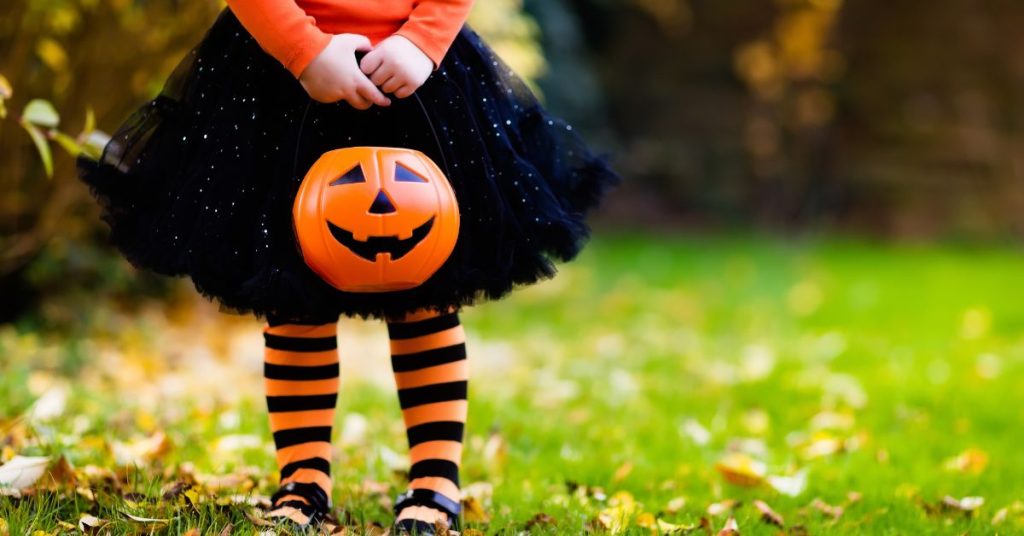

With Halloween fast approaching, everyone is wondering what costume to wear and what treats to give. It can be a tricky time for parents following a whole food, plant-based (WFPB) lifestyle, but with careful planning, you can make this a memorable, enjoyable holiday!
Children may not always appear to be listening, but they are always watching, so we should consistently demonstrate that healthy eating matters, even on holidays. The challenge with Halloween is that, for a day at least, most of the rest of the country is trying to eat as many pieces of candy and sugary desserts as possible.
According to research, one teaspoon of sugar can shut down a person’s immune system for up to 5 hours.[1] Yale University says that children should get only three to four teaspoons of sugar per day and that an adult should limit intake to five teaspoons.[2] This might sound difficult on Halloween, but you can definitely succeed with planning.
First, try to find a healthy balance for your children’s food intake and create an atmosphere of wise choices. Serving a filling, healthy meal before they go to a Halloween party or trick-or-treating will ensure that at least they aren’t eating sugary desserts and candy because of hunger. If you are hosting a party, I recommend making festive treats like pumpkin muffins, popcorn with nuts and raisins, or a spooky drink I call Goblin Goulash (a green kale smoothie). You might be surprised by how much most people enjoy fun alternatives to the sugar-laden candy that is so common.
If your child goes trick-or-treating, instruct them to wait and allow you to inspect the food they collect before they eat it. Tell them that if any candy or food they received wasn’t wrapped commercially, they should throw it away, especially if it looks like the package has been tampered with (tears, holes, discoloration, etc.). I always threw out any candy or treats my children were given if they looked suspicious. It’s not worth the risk.
Also, if you allow your children to eat candy or treats, be aware that some have a shelf life. If you allow your child to have one or two pieces per day, check the candy for freshness or an expiration date. Teach your children to do the same. Children can be very responsible if given the chance.
There are special concerns about the damage sugar causes to teeth and gums, and for good reason. Dental decay can be painful and damaging to a child’s health, and conditions affecting the mouth can challenge a person for their entire life. Help your children make the best decisions for their health today by reminding them to brush and floss after consuming sweets, but not immediately. Acidic foods and beverages temporarily soften the surface of teeth, meaning that if you brush right away, you actually increase dental erosion.[3] It’s best to rinse the mouth with water and wait at least 30 minutes before brushing. Your children will always be grateful for the love you show them, even if they do not recognize it today.
For trick-or-treaters coming your way, you can pass out non-edible treats as substitutes for candy: stickers, crayons, bubbles, kaleidoscopes, slinkies, yo-yos, sidewalk chalk, small flashlights, glow sticks, hacky sacks, funny glasses, or other fun gifts. You can find packs of these online or at the local party or craft stores. Just make sure you pick age-appropriate goodies and check that there are no small parts a child could choke on. Some gifts may be better for younger children, while others may be more fun or safer for older children.
If you prefer to hand out edible treats, maybe you want to try some commercially packaged alternatives to candy. Good options include trail mixes, raisins, popcorn packets, or nut butter crackers. People will trust sealed packages from the grocery store more than homemade items.
Regardless of what you decide, it is good to not contribute to the epidemic of sugar-related diseases. After all, childhood obesity has risen alarmingly, doubling over the last 30 years! But that does not mean Halloween should not be fun. It’s still the perfect opportunity to spend time with your family, play fun music, bob for apples, make jack-o-lanterns, and enjoy more wholesome treats like pumpkin bread. By committing to having a fun Halloween—even if it is on your terms—you show your family how much you care about them.
May you have a fun, safe Halloween!
Copyright 2025 Center for Nutrition Studies. All rights reserved.